If you’re interested in the vibrant birdlife of Pennsylvania, you’ll be captivated by the red birds that grace its skies. From the striking Northern Cardinal to the elegant Red-tailed Hawk, these crimson-hued creatures add a dash of color to the state’s avian diversity.
The American Robin, Red-winged Blackbird, and other species also proudly flaunt their red plumage. Join us on a journey to explore these fascinating feathered inhabitants, as we uncover their habits, habitats, and distinctive features in Pennsylvania’s red bird population.
Key Takeaways
- The Northern Cardinal and the House Finch are both common red birds found in Pennsylvania.
- The Purple Finch is a migratory bird that breeds in northern parts of North America and winters in southern United States and Mexico.
- The Pine Grosbeak and the Pine Siskin are both finches that feed primarily on seeds, especially from coniferous trees.
- The Common Redpoll and the Red Crossbill are both finches that have irregular migration patterns influenced by food availability.
Northern Cardinal
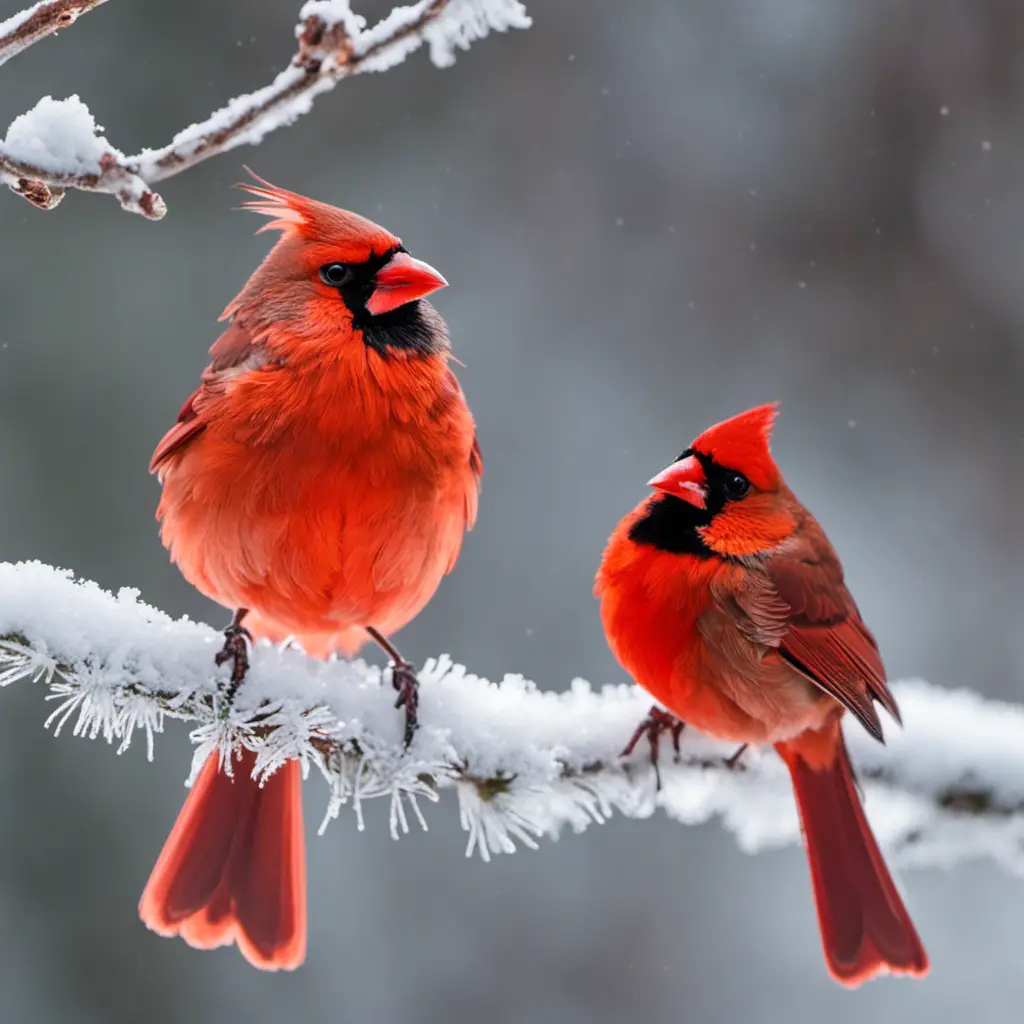
You should observe the vibrant plumage of the Northern Cardinal. This bird, scientifically known as Cardinalis cardinalis, is a common sight in the eastern part of North America, including Pennsylvania.
The Northern Cardinal is known for its bright red feathers, which are more prominent in males than females. They inhabit a variety of habitats, ranging from forests to suburban areas, as long as there are trees and shrubs for nesting and foraging.
Their behavior is fascinating to observe. Males sing beautiful, melodic songs to defend their territory and attract mates, while females have a more subdued song. They’re also known to engage in courtship feeding, where the male brings food to the female as a display of affection.
Studying the habitat and behavior of the Northern Cardinal can provide valuable insights into avian biology and ecology.
House Finch
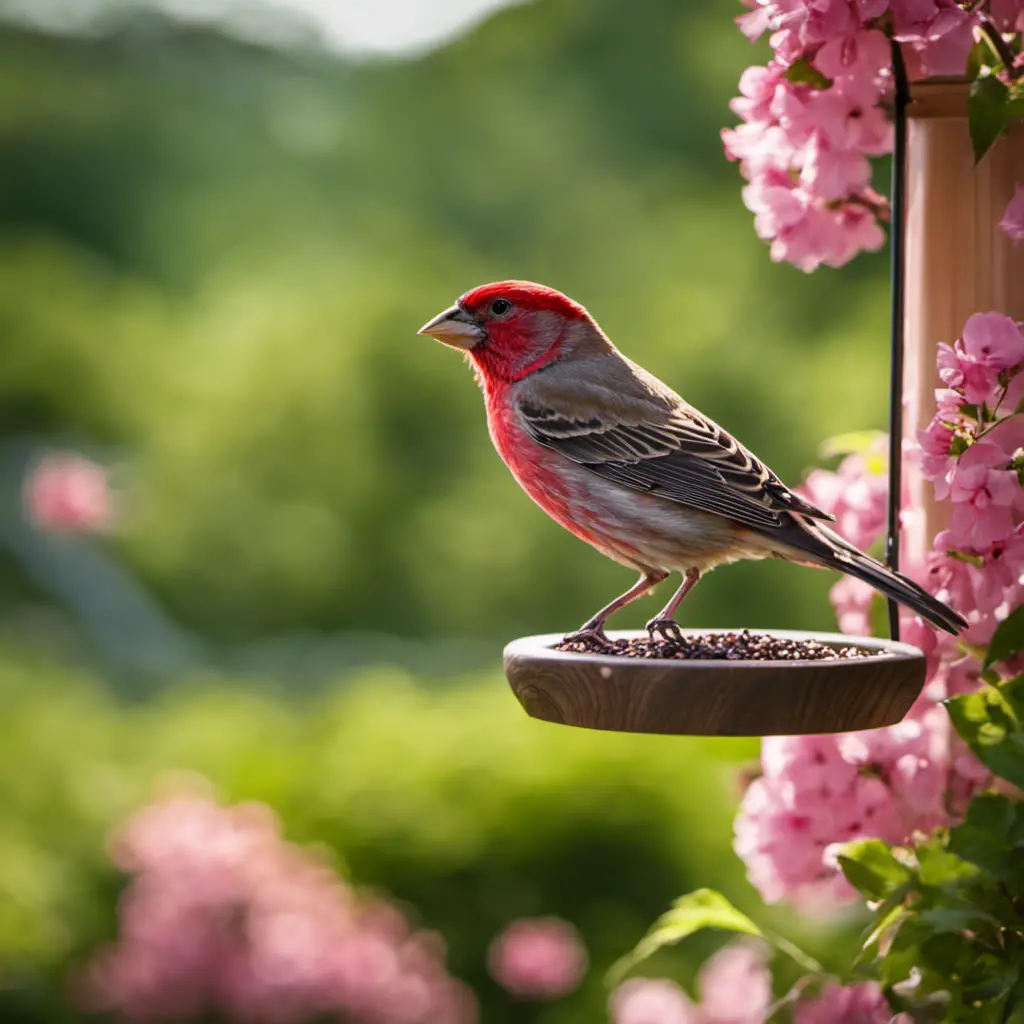
Take a closer look at the House Finch, a small songbird that’s commonly found in urban and suburban areas, and has a distinctive red plumage. This bird is known for its adaptability and can be found throughout North America.
House Finches are known to have interesting breeding habits, with males attracting females by singing complex songs and performing colorful displays. They build nests in shrubs, trees, or man-made structures, using a combination of twigs, grass, and feathers.
House Finches are non-migratory birds, meaning they don’t undertake long-distance journeys. However, they do exhibit some movements within their range, especially during harsh weather conditions or scarcity of food.
Understanding the breeding habits and migration patterns of House Finches can provide valuable insights into their survival and population dynamics.
American Robin
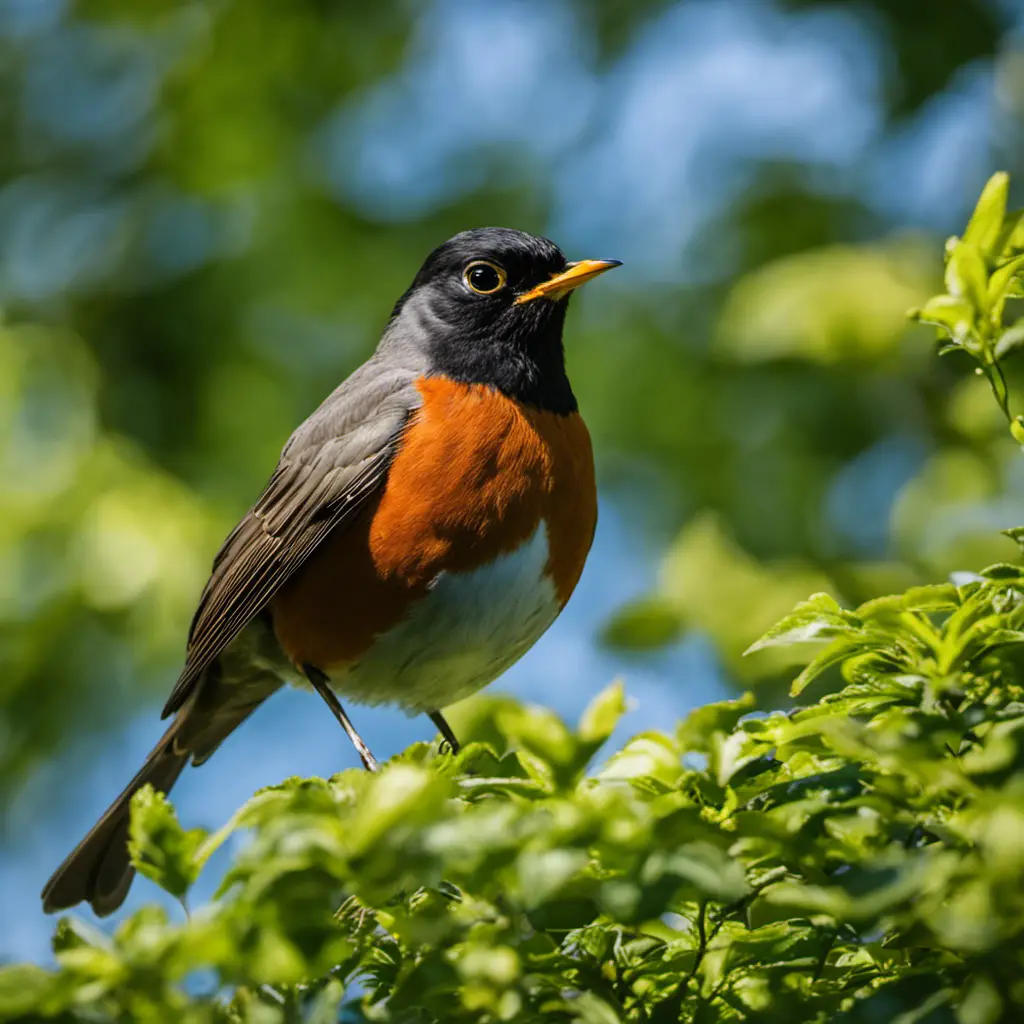
Have you noticed that the American Robin is often seen hopping around your yard during the spring and summer months?
The American Robin, scientifically known as Turdus migratorius, is a migratory songbird that’s commonly found in North America. This iconic bird is known for its vibrant red breast, gray-brown back, and white underbelly.
The American Robin is a medium-sized bird, measuring around 10 inches in length and weighing approximately 2.7 ounces. It’s a highly adaptable species, known to thrive in a variety of habitats including forests, fields, and suburban areas.
During the spring and summer months, the American Robin feeds primarily on earthworms, insects, and berries. They’re also known for their distinctive song, which is a series of melodious whistles.
The American Robin is a fascinating species that plays an important role in maintaining ecological balance. Some discussion ideas about the American Robin could include its migration patterns, breeding behavior, and its impact on local ecosystems.
Red-winged Blackbird

Don’t overlook the striking beauty of the Red-winged Blackbird’s plumage during your next birdwatching adventure. This bird, scientifically known as Agelaius phoeniceus, is known for its distinct red and yellow shoulder patches, which are prominently displayed during courtship displays. The Red-winged Blackbird is a migratory bird, with populations found throughout North America. During migration, these birds can travel long distances, often forming large flocks.
Here are some key features of the Red-winged Blackbird’s migration patterns and mating behavior:
Migration Patterns:
These birds migrate seasonally, moving between their breeding grounds in the northern parts of the continent and their wintering grounds in the southern regions.
They typically begin their migration in early spring and return to their breeding grounds in late winter or early spring.
Mating Behavior:
Male Red-winged Blackbirds are known for their elaborate courtship displays, which involve puffing up their plumage, flapping their wings, and vocalizing to attract females.
Females select mates based on the males’ displays and territory quality, as they prefer males with larger and more well-defined territories.
Understanding the migration patterns and mating behavior of the Red-winged Blackbird adds depth to your birdwatching experience and allows for a greater appreciation of this fascinating species.
Red-tailed Hawk
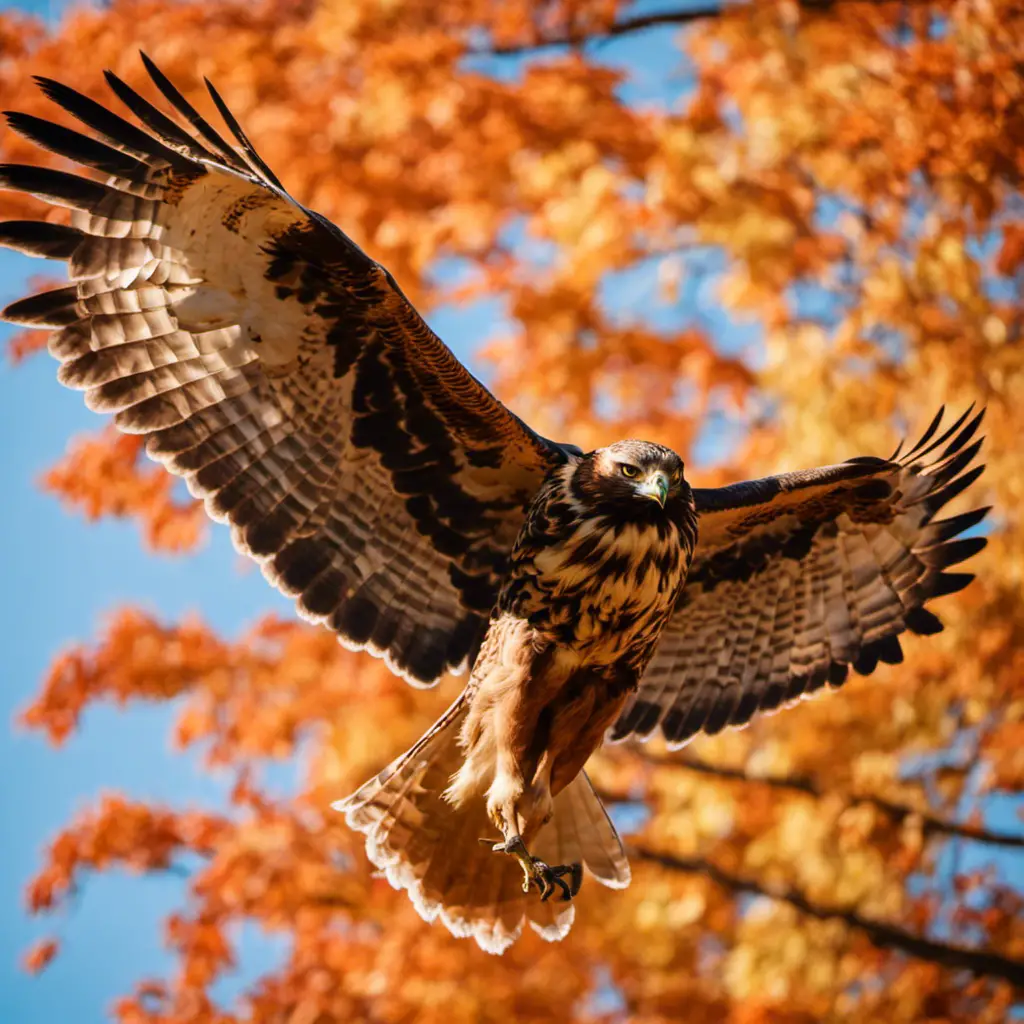
You might spot a pair of Red-tailed Hawks soaring majestically in the sky, displaying their distinctive red tails. These magnificent birds of prey are found throughout North America, including Pennsylvania. Red-tailed Hawks are known for their conservation status, as they are considered a species of least concern. Their population is stable, thanks to efforts in preserving their habitat and raising awareness about their importance in the ecosystem. Red-tailed Hawks are skilled hunters, primarily feeding on small mammals such as rodents and rabbits. They have keen eyesight and sharp talons, allowing them to capture their prey with precision. Red-tailed Hawks play a vital role in maintaining the balance of the food chain and controlling rodent populations. Conservation efforts continue to protect these magnificent birds and ensure their survival for future generations.
| CONSERVATION | HUNTING HABITS |
|---|---|
| Stable | Skilled |
| Preserved | Rodents |
| Awareness | Rabbits |
Red-bellied Woodpecker
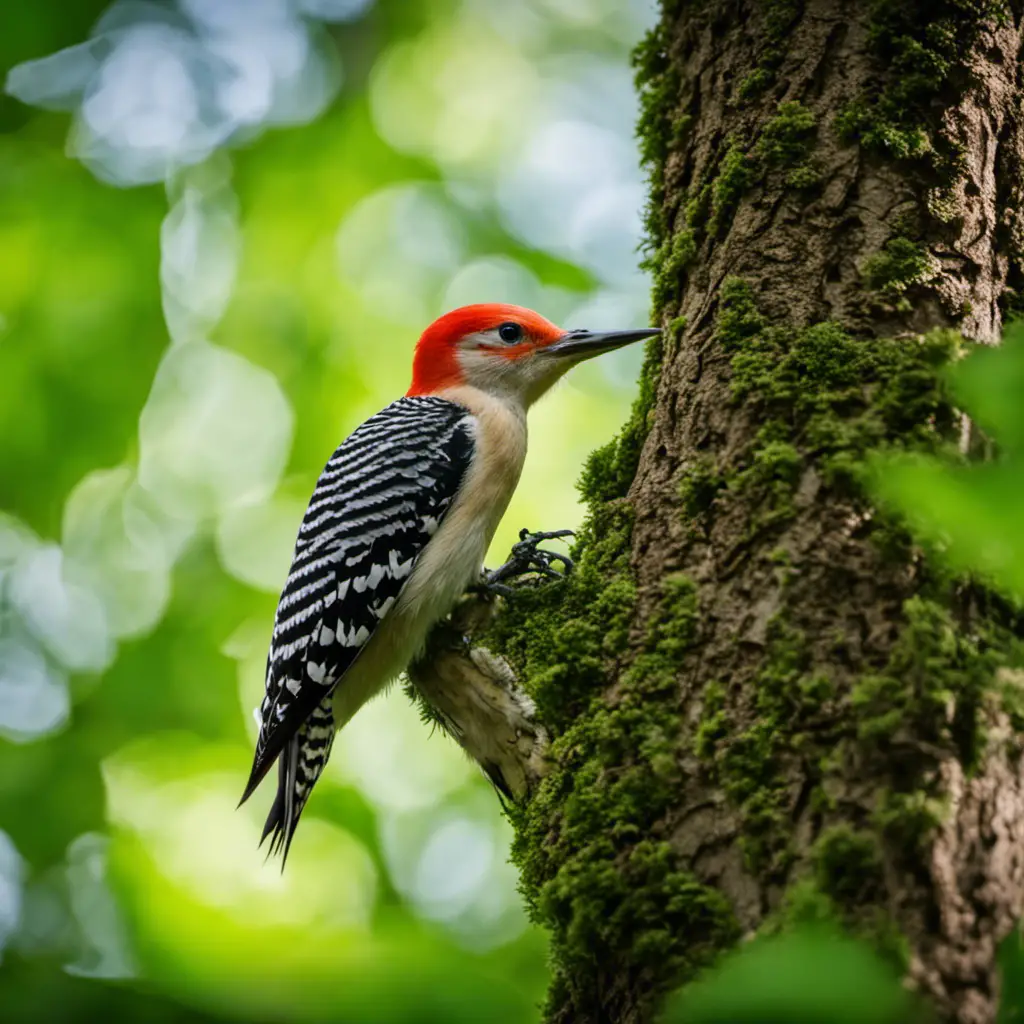
There are many different species of woodpeckers, but the Red-bellied Woodpecker is especially known for its distinctive red head and black and white striped back. This species, scientifically known as Melanerpes carolinus, exhibits interesting behavior and has a varied diet.
Behavior and Diet: The Red-bellied Woodpecker is an omnivorous bird that consumes a wide range of food. Its diet includes insects, fruits, nuts, seeds, and occasionally small vertebrates. This woodpecker uses its strong bill to drill into tree bark in search of hidden insects, and it can also catch flying insects in mid-air. It’s known for its ability to store food, often hiding it in tree crevices for later consumption.
Nesting Habits and Habitat: Red-bellied Woodpeckers are cavity nesters, meaning they excavate holes in trees to create their nests. They prefer nesting in dead or decaying trees, but will also use utility poles or wooden structures if suitable natural cavities aren’t available. Their nests are typically lined with wood chips and other soft materials. This woodpecker species is commonly found in forests, woodlands, parks, and suburban areas with mature trees.
Overall, the Red-bellied Woodpecker is a fascinating bird with unique behavior, diet, nesting habits, and habitat preferences.
Scarlet Tanager
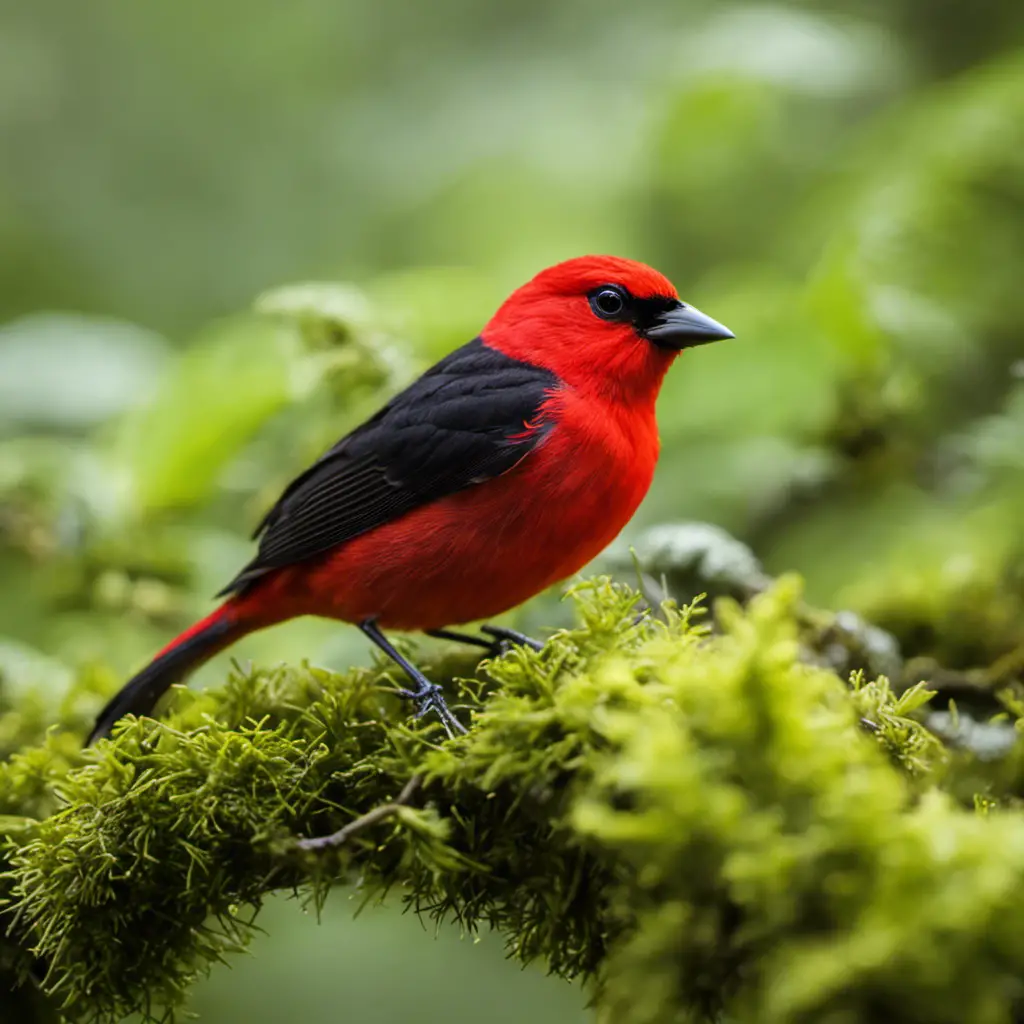
You can often spot the Scarlet Tanager in the treetops, as it showcases its vibrant red plumage. This bird is known for its stunning appearance, with males boasting a bright scarlet color and black wings, while females have a more subdued yellow-green plumage.
The Scarlet Tanager is a neotropical migrant, meaning it breeds in North America and migrates to Central and South America during the winter months. Its migration patterns are quite remarkable, as it can travel long distances, often crossing the Gulf of Mexico.
During the breeding season, these birds are known for their unique courtship behavior, with males performing elaborate displays to attract females. They build cup-shaped nests in the forest canopy, where the female lays and incubates her eggs.
Understanding the migration patterns and breeding behavior of the Scarlet Tanager is crucial for conservation efforts and ensuring the survival of this beautiful species.
Rose-breasted Grosbeak
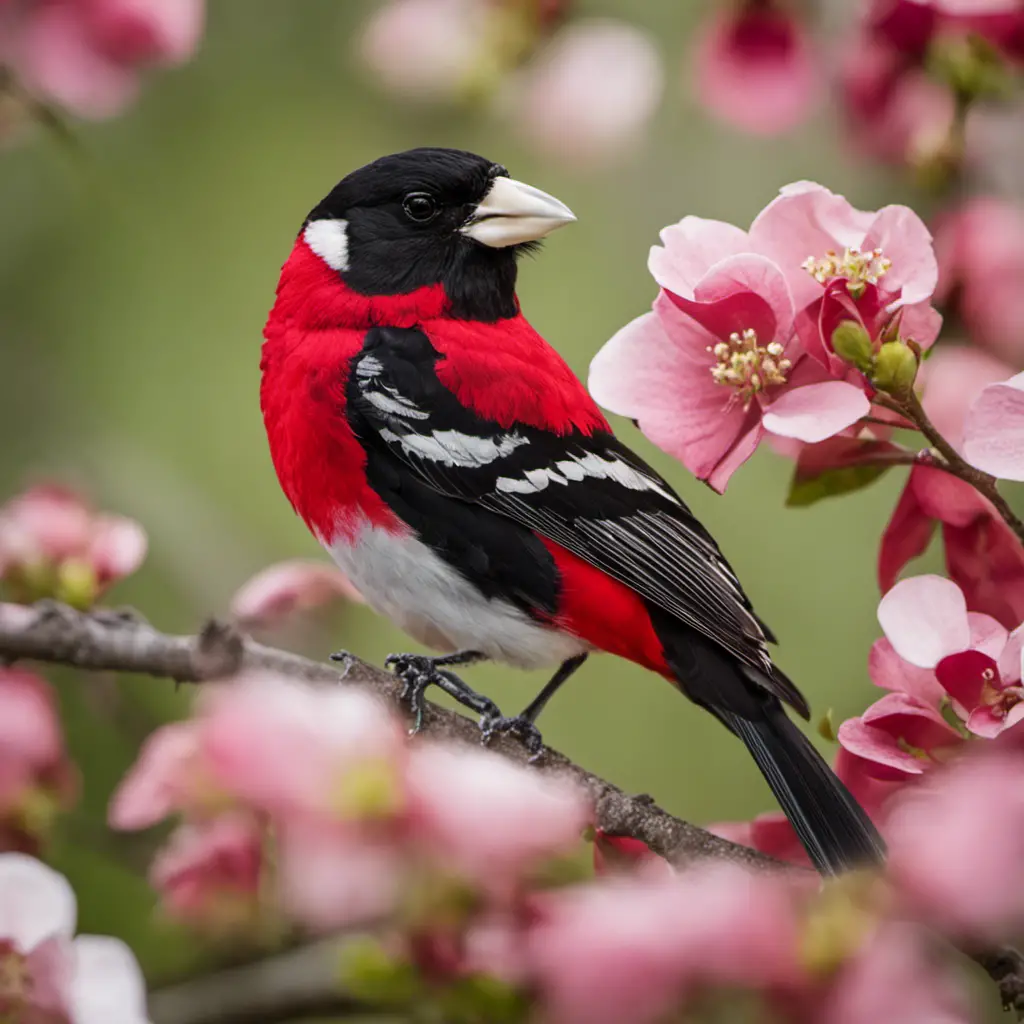
Have you seen the article about the Rose-breasted Grosbeak? This fascinating bird is known for its vibrant plumage and unique migration patterns. Here are some key points to consider:
Migration Patterns:
The Rose-breasted Grosbeak is a neotropical migrant, meaning it travels long distances between its breeding grounds in North America and its wintering grounds in Central and South America.
These birds follow a general pattern, flying south in the fall and returning north in the spring.
Some individuals may undertake a non-stop flight of over 2,500 miles during migration.
The timing and route of their migration can vary, influenced by factors such as weather conditions and availability of food along the way.
Feeding Habits:
Rose-breasted Grosbeaks have a diverse diet, primarily consisting of insects, seeds, fruits, and nectar.
During the breeding season, they consume a higher proportion of insects to meet the demands of nesting and feeding their young.
In the winter, when insects are scarce, they rely more on fruits and seeds.
These birds have a strong bill that allows them to crack open seeds and extract their food efficiently.
Understanding the migration patterns and feeding habits of the Rose-breasted Grosbeak is crucial for conservation efforts and ensuring their survival. By studying their movements and dietary preferences, researchers can better protect their habitats and promote their well-being.
Baltimore Oriole
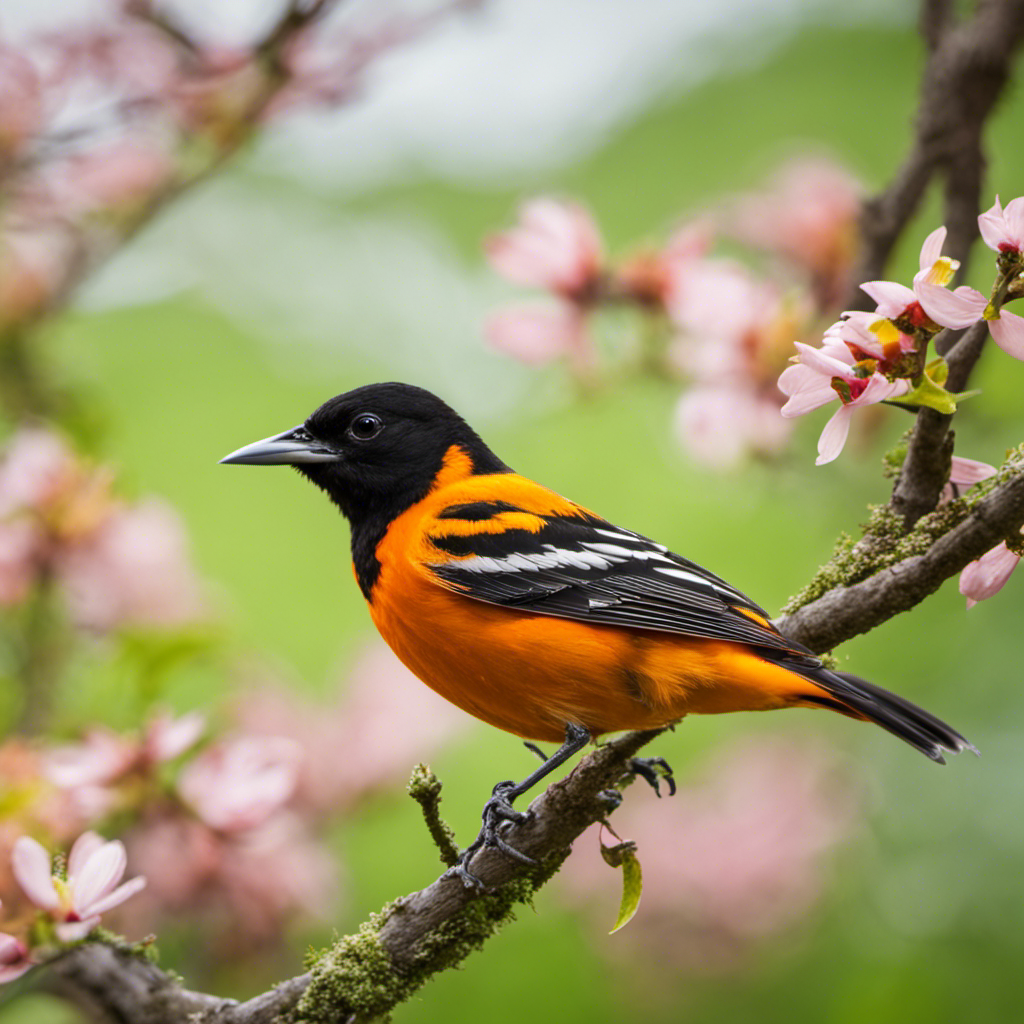
Did you know that the Baltimore Oriole can lay up to six eggs in a single clutch?
The Baltimore Oriole (Icterus galbula) is a migratory bird species that’s commonly found in North America during the summer months. These vibrant orange and black birds are known for their beautiful songs and intricate nests.
They’ve a distinctive migration pattern, traveling from their wintering grounds in Central and South America to their breeding grounds in the eastern and central parts of the United States and Canada. The timing of their migration is closely linked to the availability of food, particularly insects and fruits.
As they make their way north, these birds rely on a combination of visual cues, celestial navigation, and magnetic fields to find their way. Understanding the migration patterns of the Baltimore Oriole is crucial for conservation efforts and ensuring their habitats are protected throughout their journey.
Eastern Towhee

Sure, so the Eastern Towhee is a fascinating bird that’s commonly found in the eastern parts of the United States and Canada. It’s known for its distinct appearance and interesting behaviors.
Here are some key points about the Eastern Towhee:
Bird Identification: The Eastern Towhee is a medium-sized bird, measuring about 7-8 inches in length. The male has a black head, back, and tail, with a rusty-red underbelly and white patches on its wings. The female is similar but has a browner coloration.
Vocalization: The Eastern Towhee is known for its distinctive call, which sounds like ‘drink your tea!’ The males often sing loudly from perches to establish their territory.
Habitat: These birds prefer shrubby areas, thickets, and open woodlands. They’re commonly found near the forest edge or in overgrown fields.
Behavior: Eastern Towhees are ground-foragers, scratching the leaf litter with their feet to uncover insects, seeds, and berries. They also perform a ‘double-scratch’ behavior, where they rake both feet backward simultaneously.
Understanding the Eastern Towhee’s bird identification, vocalization, habitat, and behavior can help bird enthusiasts appreciate and identify this unique species in the wild.
Summer Tanager
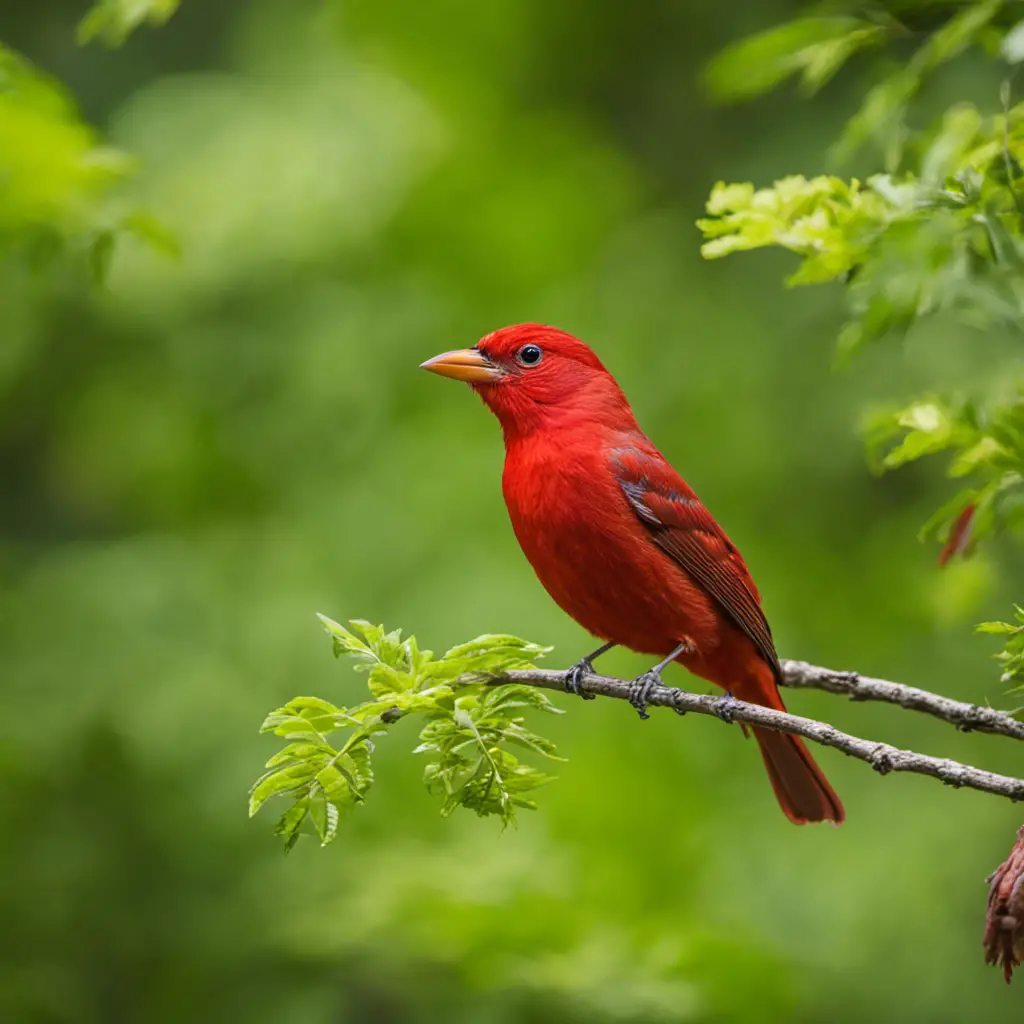
Hey, did you know that during the summer, you can spot the vibrant red Summer Tanager in Pennsylvania?
The Summer Tanager, scientifically known as Piranga rubra, is a medium-sized songbird that’s widely distributed across North and South America. Although it’s primarily found in the southern United States, it isn’t uncommon to see them in Pennsylvania during their migratory period.
These birds typically migrate to the region in the summer months, seeking suitable breeding grounds. When it comes to diet preferences, the Summer Tanager is primarily insectivorous, feeding on a variety of insects such as beetles, wasps, and bees. Additionally, they also consume fruits and berries, making them omnivorous.
Purple Finch
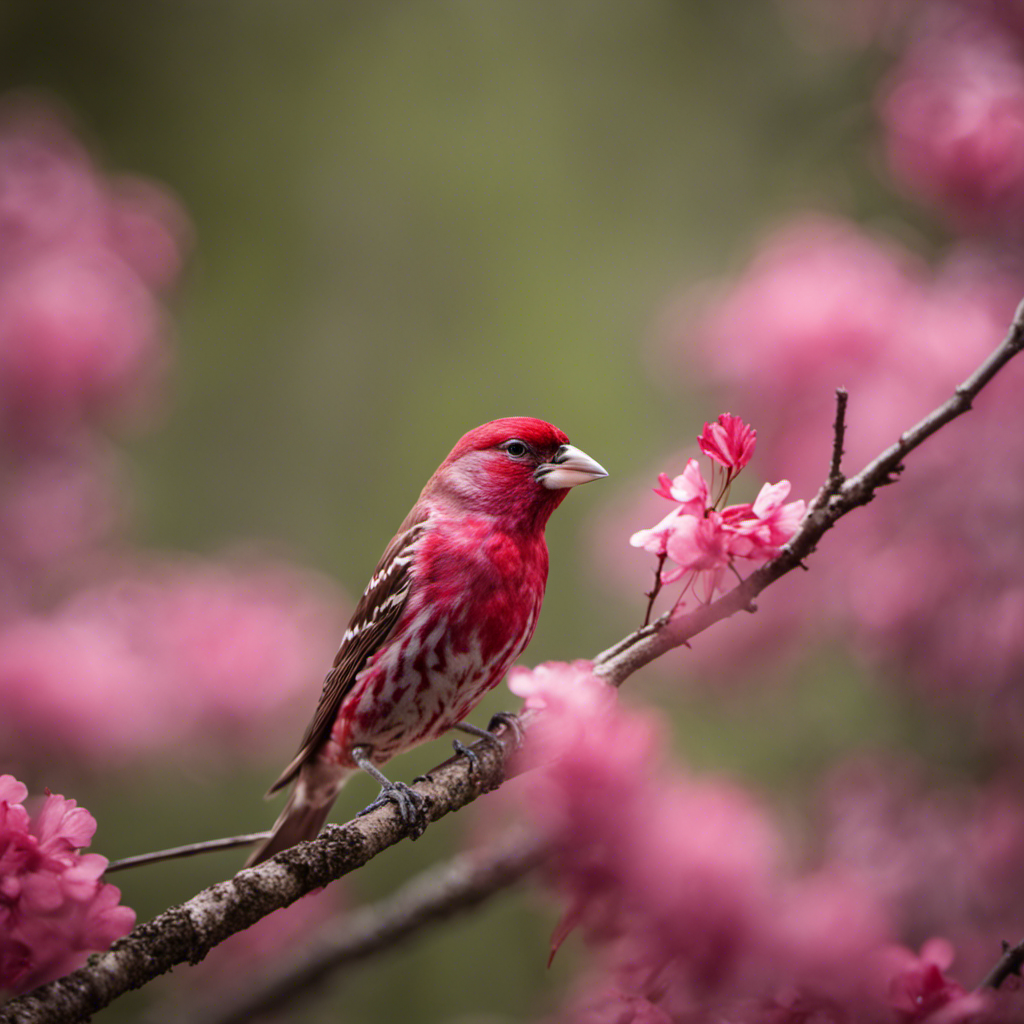
You might be interested to know that the Purple Finch is a common bird species found in Pennsylvania. This small bird, scientifically known as Haemorhous purpureus, is known for its vibrant plumage and melodious songs.
Here are some key points about the Purple Finch:
Purple Finch Migration: Purple Finches are migratory birds, meaning they travel long distances during certain times of the year. They breed in the northern parts of North America, including Pennsylvania, during the summer months. However, during the winter, they migrate southwards to regions like the southern United States and Mexico.
Purple Finch Feeding Habits: These birds primarily feed on seeds, with a preference for coniferous trees such as pine and spruce. They also consume berries and insects when available. Purple Finches are known for their strong beaks, which allow them to crack open seeds and extract their nutritious contents.
Plumage and Appearance: Male Purple Finches display a striking combination of reddish-purple and brown feathers, while females have a more subdued plumage with streaked patterns. Their colors and patterns help them blend in with their surroundings and enhance their chances of survival.
Habitat and Conservation: Purple Finches are commonly found in forests, woodlands, and suburban areas with ample trees and shrubs. While they aren’t currently listed as a threatened species, habitat loss and climate change pose potential risks to their population in the future.
Pine Grosbeak
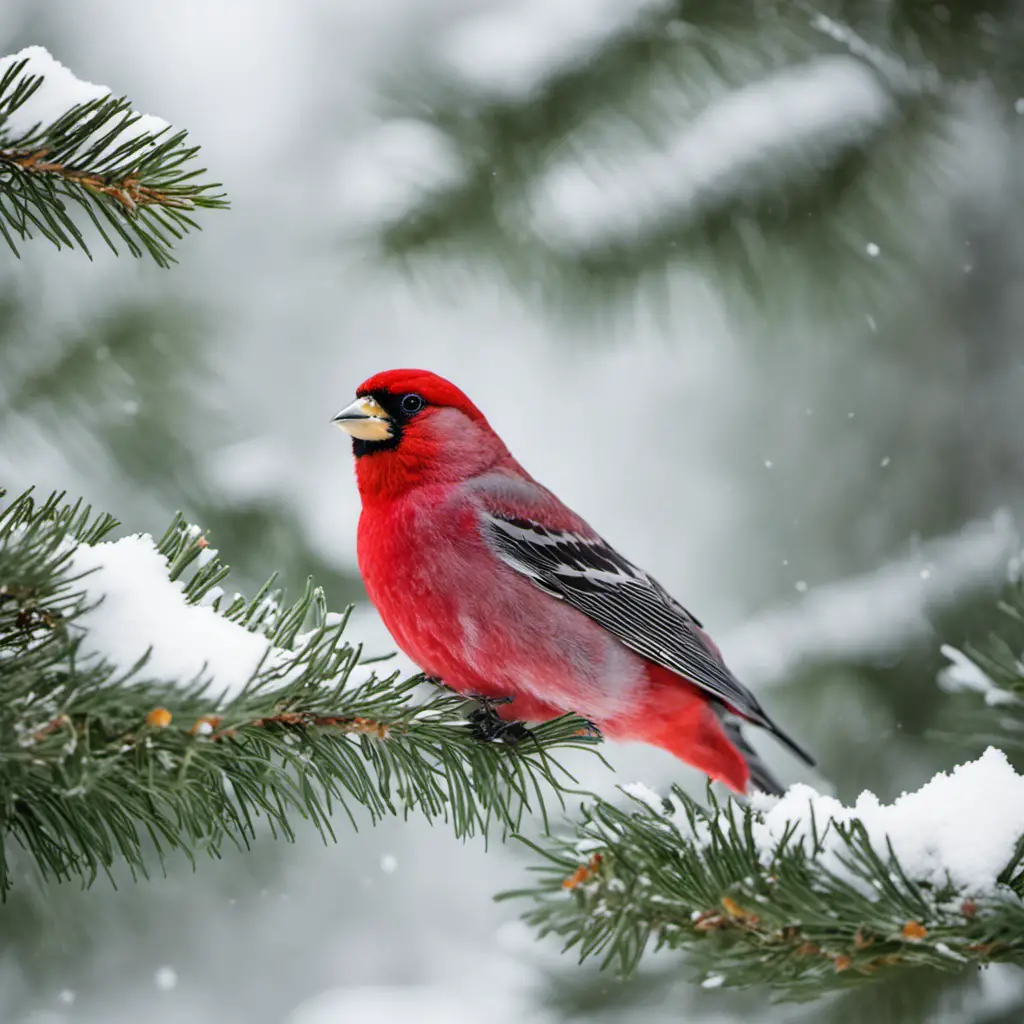
I’m glad you’re interested in the Pine Grosbeak, as they’re known for their vibrant red plumage and can often be spotted feeding on pine cones.
The Pine Grosbeak (Pinicola enucleator) is a medium-sized bird that belongs to the finch family. It’s native to the boreal forests of North America, Europe, and Asia.
The male Pine Grosbeak has a bright red body with gray wings and tail, while the female has a more dull plumage. The species is highly migratory, with some individuals traveling long distances in search of food and suitable breeding grounds.
During winter, they often descend from their mountainous breeding habitats to lower elevations, where they can be found in large flocks feeding on berries and cones.
The Pine Grosbeak’s migration patterns are influenced by factors such as food availability and weather conditions. Studying their migratory behavior provides valuable insights into their ecological requirements and population dynamics.
Pine Siskin

If you’re interested in the Pine Siskin, you might be curious to know that these small finches are often found in coniferous forests and are known for their unique chirping calls.
The Pine Siskin is a migratory bird, with its patterns varying depending on the available food sources. They primarily feed on seeds, especially those from coniferous trees like pines and spruces. However, they also consume a variety of other seeds and fruits, including those from birch, alder, and sunflowers.
During migration, Pine Siskins can travel long distances and can be found across North America, from Alaska to the southern United States. Their feeding habits play a crucial role in their migration patterns, as they follow the availability of food throughout their journey.
Common Redpoll
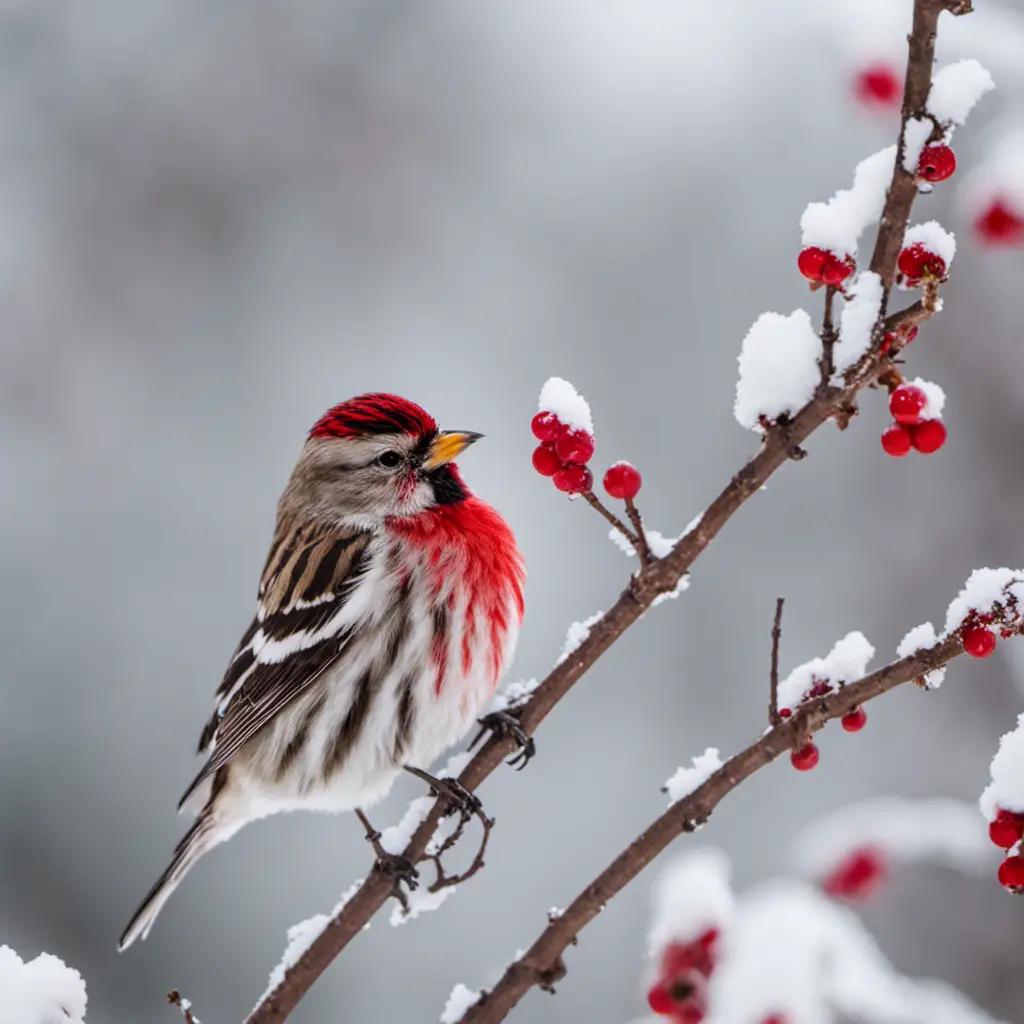
Have you ever seen a flock of Common Redpolls in your backyard or at a local park, flying in unison and feeding on the seeds of birch and alder trees? These small finches, scientifically known as Acanthis flammea, are native to the Arctic regions but occasionally migrate to Pennsylvania during the winter months. The species distribution in Pennsylvania is limited to the northern parts of the state, where they find suitable habitats with ample food resources. Conservation efforts for Common Redpolls focus on preserving their preferred habitats, promoting the planting of birch and alder trees, and raising awareness about the importance of maintaining biodiversity. Let’s take a closer look at the species distribution and conservation efforts for Common Redpoll in Pennsylvania:
Species Distribution in Pennsylvania:
| Region | Counties |
|---|---|
| North | Bradford |
| Columbia | |
| Lackawanna |
Conservation Efforts for Common Redpoll:
- Protecting their habitats through land conservation initiatives.
- Promoting the planting of birch and alder trees in suitable areas.
- Educating the public about the importance of preserving biodiversity and supporting local conservation organizations.
Red Crossbill

Do you know where to find Red Crossbills in Pennsylvania?
Red Crossbills (Loxia curvirostra) are known for their unique beak shape, which is perfectly adapted for extracting seeds from conifer cones.
Here are some key points about their habitat, feeding habits, breeding patterns, and migration behavior:
Habitat and Feeding Habits:
Red Crossbills are primarily found in coniferous forests, such as pine, spruce, and fir.
They rely heavily on conifer seeds as their main food source, using their crossed bills to pry open cones and extract the seeds.
These birds are highly specialized and can extract seeds from cones that aren’t accessible to other species.
Breeding Patterns:
Red Crossbills don’t have a specific breeding season and can breed throughout the year when food availability is high.
They typically form monogamous pairs and build their nests in conifer trees, using twigs, grass, and moss for construction.
Females usually lay 3-5 eggs, and both parents take turns incubating the eggs for about two weeks.
Migration Behavior:
Red Crossbills exhibit irregular migration patterns, often influenced by food availability.
They may move long distances in search of suitable cone crops, leading to fluctuations in their presence in different regions.
Some populations of Red Crossbills are considered nomadic, constantly moving in search of abundant food sources.
Understanding the habitat, feeding habits, breeding patterns, and migration behavior of Red Crossbills can help bird enthusiasts and researchers locate and study these fascinating birds in Pennsylvania.
White-winged Crossbill
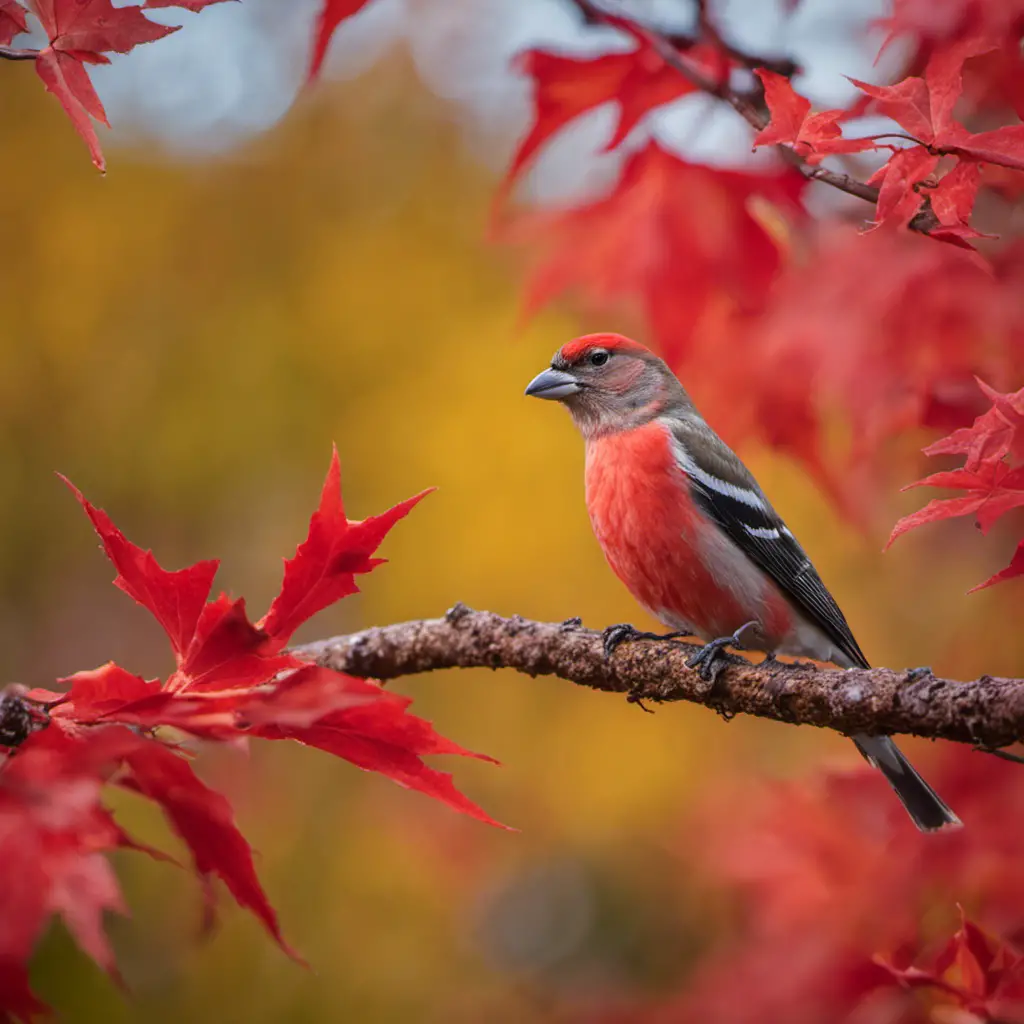
You might occasionally spot White-winged Crossbills if you keep an eye out for them in Pennsylvania. These small birds are known for their distinctive crossed bills, which are specially adapted for extracting seeds from conifer cones. White-winged Crossbills have a unique feeding behavior, using their crossed bills to pry open conifer cones and extract the seeds inside. They are highly specialized in their diet, primarily feeding on the seeds of spruce, pine, and fir trees. Their habitat preferences include coniferous forests, where they can find an abundant supply of cone-bearing trees. Here is a table summarizing the habitat preferences and feeding behavior of White-winged Crossbills:
| Habitat Preferences | Feeding Behavior | |
|---|---|---|
| Food | Coniferous forests | Extracting seeds from |
| conifer cones | ||
| Shelter | Dense tree canopies | |
| Nesting | Coniferous trees | |
Evening Grosbeak

If you’re lucky, you might spot an Evening Grosbeak in Pennsylvania during the winter months. These vibrant birds are known for their striking yellow, black, and white plumage, making them a sight to behold.
Evening Grosbeaks are nomadic birds, and their migration patterns can vary greatly from year to year. They’re known to move in large flocks, searching for food sources like seeds, buds, and berries. These birds have powerful beaks designed for cracking open tough shells, allowing them to access the nutritious seeds within.
They’re also known to visit bird feeders, where they can be observed closely. Understanding the migration patterns and feeding habits of Evening Grosbeaks is crucial for conservation efforts and managing their populations effectively.
Red-breasted Nuthatch

You can easily identify the Red-breasted Nuthatch by its reddish-brown plumage and distinctive call. This small songbird is found in coniferous forests throughout North America, including Pennsylvania. The Red-breasted Nuthatch is known for its unique behavior during bird migration. While many birds migrate south for the winter, the Red-breasted Nuthatch has a different strategy. It undergoes what is called "irruption," where it moves southward in large numbers when its primary food source, pine seeds, becomes scarce in its breeding grounds.
To further understand the migration patterns of the Red-breasted Nuthatch, let’s take a look at the table below:
| Season | Location |
|---|---|
| Spring | Northern U.S. |
| Summer | Canada |
| Fall | Southern U.S. |
| Winter | Mid-Atlantic |
As the table shows, during the spring and summer, the Red-breasted Nuthatch can be found in the northern parts of the United States and Canada. However, during the fall and winter months, it migrates to the southern parts of the United States, including the Mid-Atlantic region.
Brown Creeper
When observing the Brown Creeper, keep in mind that it moves in a spiral pattern up tree trunks in search of insects, using its long, curved bill to extract prey from bark crevices. This unique behavior allows the bird to effectively forage for food in its woodland habitat.
The brown creeper’s spiral movement allows it to cover a larger surface area and explore different parts of the tree trunk, increasing its chances of finding hidden insects. Additionally, the bird’s long, curved bill is perfectly adapted for extracting prey from narrow bark crevices, where insects often hide.
Red-headed Woodpecker
You’ll be amazed at how beautifully the Red-headed Woodpecker stands out with its vibrant red plumage. This stunning bird, known scientifically as Melanerpes erythrocephalus, is a medium-sized woodpecker species found in North America.
The conservation of the Red-headed Woodpecker is a topic of concern due to its declining population numbers. This decline is primarily attributed to the loss of suitable habitat, as these woodpeckers have specific preferences when it comes to their habitat. They’re commonly found in open woodlands, savannas, and wetland edges with a mix of mature trees and open spaces.
They rely on dead trees for nesting and foraging, utilizing their strong bills to drum on trees and search for insects. Efforts are being made to protect and restore these habitats to ensure the survival of this remarkable bird species.
Pileated Woodpecker
If you look closely, you’ll notice that the Pileated Woodpecker has a distinct red crest on its head. This large woodpecker species, found in North America, is known for its striking appearance and unique behavior patterns. Here are some key points to understand about the Pileated Woodpecker:
Behavior patterns:
Drumming: Pileated Woodpeckers produce loud drumming sounds by pecking on trees, which serve as territorial displays and communication signals.
Foraging: They excavate large rectangular-shaped holes in search of insects, ants, and beetle larvae.
Vocalizations: Their calls consist of a loud, high-pitched ‘wick-a-wick-a-wick’ or a descending ‘klee-yer’ sound.
Nesting: Pileated Woodpeckers create their nests in cavities of dead or partially dead trees, often near water sources.
Habitat preferences:
Forests: They primarily inhabit mature and old-growth forests with large trees, as they require suitable nesting sites and foraging opportunities.
Deciduous and coniferous mix: Pileated Woodpeckers can be found in various forest types, including those with a mix of deciduous and coniferous trees.
Forest edges: They’re also known to frequent forest edges, where they can find a balance between open spaces and tree cover.
Understanding the behavior patterns and habitat preferences of the Pileated Woodpecker helps us appreciate and conserve this iconic bird species.
Red-shouldered Hawk
Have you seen the Red-shouldered Hawk soaring in the sky, searching for prey with its keen eyes? This majestic raptor, scientifically known as Buteo lineatus, has interesting migration patterns and specific habitat preferences.
Red-shouldered Hawks are known to be partial migrants, meaning that some individuals migrate while others remain in their breeding grounds year-round. The migration of these hawks is influenced by factors such as food availability and weather conditions.
During the breeding season, these birds prefer to inhabit deciduous forests near water sources, where they can find their preferred prey, including small mammals, reptiles, and amphibians. They also require tall trees for nesting, typically choosing the lower canopy or mid-story levels.
Understanding these migration patterns and habitat preferences is crucial for conservation efforts to ensure the survival of this fascinating species.
Turkey Vulture
You can often spot the Turkey Vulture soaring gracefully in the sky, using its keen sense of smell to locate carrion. These scavenger birds play an important role in our ecosystem by cleaning up dead animals.
Here are some key facts about the Turkey Vulture:
Appearance: The Turkey Vulture has a wingspan of up to 6 feet and is easily recognized by its dark brown feathers and featherless red head.
Feeding Habits: Their keen sense of smell allows them to locate carrion from great distances. They prefer to feed on fresh carcasses, but will also scavenge on older ones.
Flight: The Turkey Vulture uses thermal updrafts to effortlessly glide through the air. They can reach speeds of up to 60 miles per hour.
Breeding: These birds mate for life and build their nests in secluded areas such as caves or hollow trees. The female typically lays 1-3 eggs per clutch.
Understanding the role of the Turkey Vulture as a scavenger bird helps us appreciate their significance in maintaining a healthy ecosystem.
Northern Flicker
The Northern Flicker is a type of woodpecker that can be easily identified by its unique red markings and distinctive call. This bird is found across North America and is commonly seen in Pennsylvania. The Northern Flicker’s habitat includes a variety of environments such as forests, woodlands, and even suburban areas with mature trees. It is a versatile species that can adapt to different habitats as long as there are suitable trees for nesting and foraging. Speaking of foraging, the Northern Flicker has a diverse diet consisting of insects, ants, beetles, berries, and fruits. It uses its strong beak to drill into trees and the ground to find food. The following table provides a summary of the Northern Flicker’s habitat and diet:
| Northern Flicker Habitat | Northern Flicker Diet |
|---|---|
| Forests | Insects |
| Woodlands | Ants |
| Suburban areas | Beetles |
| Berries | |
| Fruits |
Frequently Asked Questions
Are There Any Other Red Bird Species in Pennsylvania Besides the Ones Mentioned?
There are indeed other red bird species in Pennsylvania besides the ones mentioned. This offers birdwatching enthusiasts a plethora of opportunities to observe and study the diverse avian population in the state.
Do All of These Red Bird Species Have Similar Habitats or Do They Prefer Different Environments?
Do all of these red bird species have similar habitats or do they prefer different environments? Red bird species in Pennsylvania vary in their habitat preferences. Some prefer woodlands, while others thrive in open fields or near water sources.
Are Any of These Red Bird Species Endangered or Threatened in Pennsylvania?
Are any of these red bird species endangered or threatened in Pennsylvania? Conservation efforts for red bird species in Pennsylvania focus on protecting their habitats, monitoring populations, and implementing strategies to mitigate threats to their survival.
Do Any of These Red Bird Species Migrate or Are They Year-Round Residents in Pennsylvania?
Red bird species in Pennsylvania have varying migration patterns. Some are year-round residents, while others migrate. Climate change can impact their populations, as it affects food sources and habitats.
Are These Red Bird Species Commonly Seen in Urban Areas or Are They Mostly Found in Rural or Forested Areas?
Red bird species in Pennsylvania have varying distributions. Factors such as habitat availability, food sources, and human activities influence their population. Some red birds are commonly seen in urban areas, while others are mostly found in rural or forested areas.
Do Blue Birds and Red Birds Coexist in Pennsylvania?
Blue birds in pennsylvania are a common sight, but do they coexist with red birds? In reality, blue birds and red birds do live in the same area, with the Eastern Bluebird and Northern Cardinal being two examples. These colorful birds bring beauty and diversity to Pennsylvania’s avian population, making it a delight for birdwatchers and nature enthusiasts alike.
Conclusion
In conclusion, Pennsylvania is home to a diverse array of red birds. The Northern Cardinal, House Finch, American Robin, Red-winged Blackbird, Red-tailed Hawk, Pileated Woodpecker, Red-shouldered Hawk, Turkey Vulture, and Northern Flicker are all prominent species found in the state.
These birds play important roles in the ecosystem, contributing to seed dispersal, insect control, and maintaining balance in the food chain.
Studying and protecting these red birds is crucial for the preservation of Pennsylvania’s natural heritage.

An avid ornithologist, zoologist and biologist with an unwavering passion for birds and wild animals.
Dr. Wilson’s journey in ornithology began in childhood and led him to obtain a Ph.D. in Ornithology from the prestigious Avian Research Institute. He has worked closely with renowned experts in the field and conducted extensive research and field studies globally.

